| Construction Rating: | starstarstarstarstar_border |
| Flight Rating: | starstarstarstar_borderstar_border |
| Overall Rating: | starstarstarstar_borderstar_border |
| Manufacturer: | Sheri's Hot Rockets  |
| Style: | Scale |

Brief:
I don't think anyone would argue that the Saturn V is the Cadillac of rockets. Well, that being the case, then the Mercury Atlas has to be the Corvette. The rocket is a stunning piece of American engineering and a critical piece of American space flight history. The Sheri's Hot Rocket version of the Mercury Atlas is equally stunning a model rocket as the original one. The build through flight proved to be a rewarding experience that culminated in a beautiful flight.
Construction:
The kit arrived at my doorstep about a month after ordering. Up front, Sheri will tell you that these kits are custom made and that you are to expect some length of delivery time. When the kit arrived, it was packed tightly in a pretty small box. I was amazed that it all fit, but everything was packed neatly and well protected. The kit included:
- 5.00" x 26" main body tube
- 5.00" coupler
- 3.125" x 7.5" support tube
- 29mm motor tube (19-3/8" long)
- 3 ¼" plywood centering rings
- heavy-duty nylon shock cord
- Lexan fins (pre-cut)
- Styrene corrugation panels
- Styrene strips and tubing
- Resin-cast capsule
- 3 Resin nozzles
- Parts for Escape tower (tubing, plywood and resin)
- Styrofoam pieces for equipment pods
- Assorted hardware, (fin attachment and Lugs)
- Waterslide decals
- Monokote Mylar Chrome Trim sheets
- Large hand-drawn blueprint and instructions
Probably my favorite thing about this kit is that Sheri provides is a full size set of plans for this rocket. The drawings are clear and make a great reference when building this rocket. I would also add that if you are interested in a great reference, there is none better than the drawings available from David Weeks.
Construction begins on the main booster. The lower centering ring (CR) is ¼" ply with lobs that form the lower nacelle/booster fairing bulkhead. I call them "mouse ears". I prepped the lower CR per the instructions by adding blind nuts for attaching the fins. The fins are attached via ¼-20 nuts and bolts along with "L" brackets. At this point, I knew this thing needed to lose some weight so I added to 5/32" blind nuts to hold the outboard nozzles. The main BT is a U-Line shipping tube. U-Line tubes have a wall thickness just shy of ¼ inch. Additionally, they have pretty heavy grooves and that could be a nightmare to try and finish, however, what I quickly found out was that Sheri provides a way to get a smooth finish on this tube. It is wrapped completely in 0.10" sheet styrene. This flawless surface is needed to get the smooth finish for the trademark Mercury Atlas polished finish. What did worry me was the weight of the tube. That will come into play for the flight of this rocket.
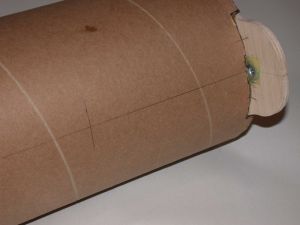 Small cutouts are made in the base of the BT to accept the lower CR. Once that is in, it is now time to add the framework, resin pieces, and sheet styrene that form the nacelles/booster fairing. If you follow the instructions, this works very well to produce a convincing lower BT section. After completing that, it's time to add the 0.10" sheet styrene wraps. This can be very frustrating (ready any review on the Estes Saturn V about the vacuform wraps!) but if done correctly, the finish is remarkable. The joints line up under other details to totally hide the seams. One frustrating part was the pre-cut corrugated styrene pieces on the lower booster section were the wrong shape. A better option would have been to leave them long and let the modeler cut to shape. I realize this would make the build a little more difficult, however, no modeler building this rocket would find it hard.
Small cutouts are made in the base of the BT to accept the lower CR. Once that is in, it is now time to add the framework, resin pieces, and sheet styrene that form the nacelles/booster fairing. If you follow the instructions, this works very well to produce a convincing lower BT section. After completing that, it's time to add the 0.10" sheet styrene wraps. This can be very frustrating (ready any review on the Estes Saturn V about the vacuform wraps!) but if done correctly, the finish is remarkable. The joints line up under other details to totally hide the seams. One frustrating part was the pre-cut corrugated styrene pieces on the lower booster section were the wrong shape. A better option would have been to leave them long and let the modeler cut to shape. I realize this would make the build a little more difficult, however, no modeler building this rocket would find it hard.

At this point, it's time to add the equipment pods. These are the two nacelles on opposite sides of the main BT that are capped by resin triangle shaped cones. The pods are made from hot wired shaped Styrofoam plugs. These are also covered in 0.10" sheet styrene. One word of caution, you have to use special glue for Styrofoam otherwise either the styrene won't stick or the foam will melt. The instructions provide a recommended brand. After the equipment pods are completed, it is time to the final details for the booster.
When adding the upper equipment fairings (nose cone type pieces) and the Vernier rocket pods, I took a sheet of sandpaper and a 4" piece of PVC pipe and shaped the back of the parts to create a better fit to the main BT. Additionally, I drilled 1/16" holes in the resin pieces and pinned them to the BT for added strength.
Now the fun part! Adding the Monokote Chrome trim sheets. This gives the Atlas the distinctive finish. The sheets are 4" wide. The real Atlas booster has 16 stainless steel tank sections on the lower portion of the booster. If you go with the Monokote trim sheets, you'll get 5 with a small piece left over. I went somewhere in the middle with 8 sections for a more realistic look. If you have done a reasonably good job on the styrene, you can produce a nice finish with the Monokote sheets.
Now comes the more difficult part of the build: the upper booster section and transition to the capsule. The distinctive taper on the Atlas is made from a very basic set of parts. A piece of 3.125" tubing is glued to the upper CR and a transition is formed with a piece of pre-cut styrene. Three quick steps and you have a transition. The capsule is then glued to that transition. There is about 3" of BT showing so you cover that with corrugated sheet styrene. Very fast and convincing. To complete this portion, Sheri has you build a coupler out of a piece of main BT. This is easy but can be troublesome if it is not lined up correctly.
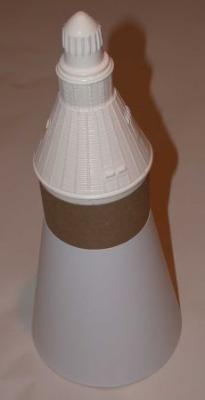
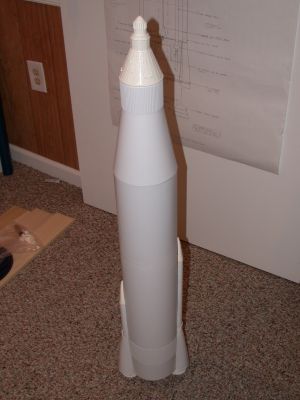
At this point, you have a very convincing Mercury Atlas! Now comes what I considered the most difficult part of the build. Figuring out how to wrap the transition with Monokote. Not hard but cumbersome to get right. I quickly decided that I would make paper patterns using the "Robert Blaske's Shroud Calculator" found in the tools section of EMRR! This required a beam compass due to the lengths involved. This worked perfectly and created the perfect effect. One comment on the capsule: paint does not like to stick to this thing (or any of the resin for that matter). I scrubbed and bleached and did all sorts of things to get paint to stick, but in the end, I basically used self-etching auto primer for a base coat and that worked. Your mileage may vary.
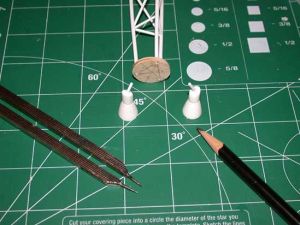 The Escape Tower was next. The construction was unremarkable except that I pinned all joints at the tip and base of the tower in an effort to improve the strength. This will prove to be a good thing during the first flight.
The Escape Tower was next. The construction was unremarkable except that I pinned all joints at the tip and base of the tower in an effort to improve the strength. This will prove to be a good thing during the first flight.
After decals are added and the screw-eye launch lugs (yes, screw-eyes), the rocket is basically complete. Time to fly!
Construction Rating: 4 out of 5
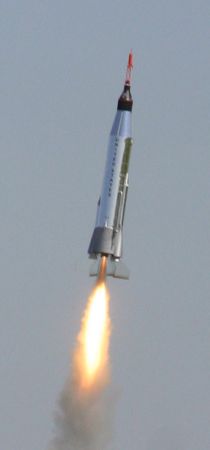 Flight:
Flight:
I loaded up the rocket with a 60" nylon parachute (recommended) and placed it on the pad at Red Glare VI. The button was pushed and the rocket boosted into the sky. I was a beautiful sight. Very realistic. The only casualty was the Escape Tower. While prepping for the flight, I discussed with Foose4string what I thought would happen to the tower on the flight. I knew the escape tower was a goner before I even launched. Sure enough, it made it through ejection, then sheared off like we thought. I was able to recover the parts so it will be rebuilt!
This is where my love-hate view of this rocket comes into play. I constructed this rocket exactly by the plans. No added extras. In fact, I actually drilled out the outboard solid rocket nozzles (Engines No. 1 and 2) in an effort to reduce weight. This thing weights a ton! 5.4 pounds ready to fly without a motor! In my opinion, in order to get a safe altitude, I had to fly this on a 29mm H128. I simmed this every way I could but couldn't get a good balance between altitude and launch rod speed at liftoff. With the H128 the rocket flew to about 430 feet and the short delay was about 2.5-3.0 seconds too long. If I fly it again, I'm going with at least an H180.
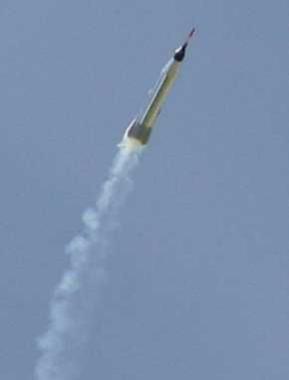

Recovery:
The boost and glide phase of the flight was spectacular. The delay grain was the "short" provided by AeroTech but that was too long. The rocket was clearly in a nose down attitude when the parachute deployed. This caused the capsule to snap to an upright position and the recovery lanyard sheared off the escape tower. In the pictures of the launch, you can clearly see the tower separate. The 60" chute proved to be about right. I used a homemade 60" hemispherical chute that I thought might be a little overkill, but it brought the rocket down smoothly. I was hoping for that "original orange and white" recovery look. It was spot on! Once on the ground, the rocket dragged a little in the field. This caused scratches on the Monokote. Be forewarned, the scratches are inevitable.
Flight Rating: 3 out of 5
Summary:
I will say this about the flight. The glide phase was about as realistic as it gets. It was a beautiful thing to see. I was happy that the flight was just what I expected. The main drawback of this kit is the weight. In order to get this thing to fly on a G motor, you'll need to make it as light as possible. To me that means basically rebuilding all the components with lighter materials. Then, what would be the point of the kit?! I think Sheri's design of the Mercury Atlas kit is spot on. I don't see a better way to do this model in terms of design. If I were to rebuild this model, I'd use a different BT, smaller CRs and hollow out the resin components as much as possible. The fact that the BT is wrapped in styrene gives it enough strength. The U-line BT is too heavy. I would not fly this on a G.
Many thanks to Peter Abresch for capturing the flight.
PROs: Design. Well thought out construction. LOOKS!
CONs: Too heavy. Large components.
Overall Rating: 3 out of 5
Sponsored Ads
 |
 |











